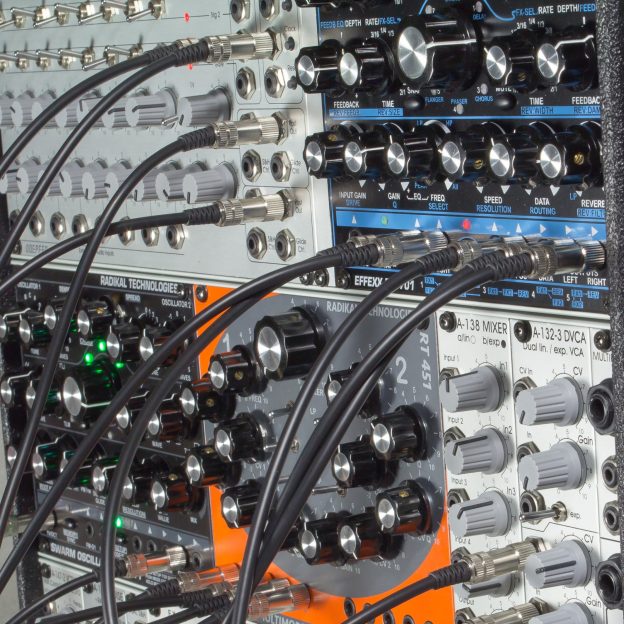![]() This example shows the most important aspect of working with modular synths – breaking the rulez. In standard synthesizers you have basicly three different groups of modules: sound generators, sound shapers and modulators. In most cases they are connected in a fixed routing configuration. At a modular system, the routing is completely free and noone stops you from using a modulator as a sound source or an oscillator as a modulation source. In this example, I fed a LFO and the Gate output of a step sequencer as the sound source into the RT-451 filter for a rhythmic structure. I recorded two different rhythms with different tempos (breaking the rules II) and I fed the RT-311 swarm oscillator into the RT-451 filter in the third recording. Instead of using a complete voice structure with ADSRs and VCAs I simply controlled the volume of the oscillator with a fader on my mixing desk. All three recording tracks are processed with the new EFFEXX multi effect module RT-1701.
This example shows the most important aspect of working with modular synths – breaking the rulez. In standard synthesizers you have basicly three different groups of modules: sound generators, sound shapers and modulators. In most cases they are connected in a fixed routing configuration. At a modular system, the routing is completely free and noone stops you from using a modulator as a sound source or an oscillator as a modulation source. In this example, I fed a LFO and the Gate output of a step sequencer as the sound source into the RT-451 filter for a rhythmic structure. I recorded two different rhythms with different tempos (breaking the rules II) and I fed the RT-311 swarm oscillator into the RT-451 filter in the third recording. Instead of using a complete voice structure with ADSRs and VCAs I simply controlled the volume of the oscillator with a fader on my mixing desk. All three recording tracks are processed with the new EFFEXX multi effect module RT-1701.
![]() In diesem Beispiel geht es um den wichtigsten Aspekt bei der Arbeit mit Modularsynthesizern: Dem Brechen von Regeln. Bei Synthesizern kann man die einzelnen klangbestimmenden Module in drei Hauptgruppen unterteilen: Klangquellen, Klangveränderer und Modulatoren. Ferner ist sind die Verbindungen zwischen diesen Elementen in der Regel weitgehend festgelegt. Bei einem modularen Synthesizer nimmt der Nutzer die Verbindungen zwischen den Modulen selbst vor und entscheidet unabhängig der eigentlichen Bestimmung darüber, in welcher der eben aufgeführten Gruppe das Modul bei einer Klangeinstellung eingesetzt wird. In dem Beispiel oben gibt es drei aufgenommene Spuren. Als Klangquellen kommt zum einen der Gate-Ausgang eines Step-Sequenzers, zum anderen der Ausgang eines LFOs und als letztes der Swarm Oscillator RT-311 als Klangquellen zum Einsatz. Alle drei Spuren gehen über das RT-451 Multimode Filter in das EFFEXX RT-1701 Effekt Modul.
In diesem Beispiel geht es um den wichtigsten Aspekt bei der Arbeit mit Modularsynthesizern: Dem Brechen von Regeln. Bei Synthesizern kann man die einzelnen klangbestimmenden Module in drei Hauptgruppen unterteilen: Klangquellen, Klangveränderer und Modulatoren. Ferner ist sind die Verbindungen zwischen diesen Elementen in der Regel weitgehend festgelegt. Bei einem modularen Synthesizer nimmt der Nutzer die Verbindungen zwischen den Modulen selbst vor und entscheidet unabhängig der eigentlichen Bestimmung darüber, in welcher der eben aufgeführten Gruppe das Modul bei einer Klangeinstellung eingesetzt wird. In dem Beispiel oben gibt es drei aufgenommene Spuren. Als Klangquellen kommt zum einen der Gate-Ausgang eines Step-Sequenzers, zum anderen der Ausgang eines LFOs und als letztes der Swarm Oscillator RT-311 als Klangquellen zum Einsatz. Alle drei Spuren gehen über das RT-451 Multimode Filter in das EFFEXX RT-1701 Effekt Modul.
